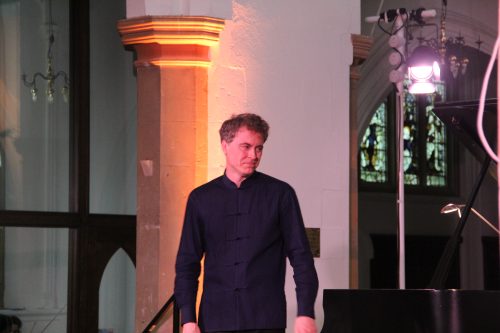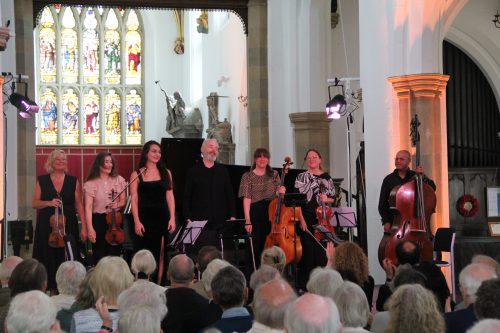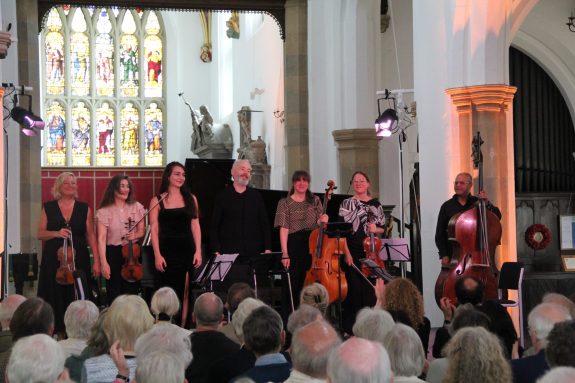 United Kingdom Midsummer Music Festival 2024: St Mary’s Church, Amersham. 8.6.2024. (CSa)
United Kingdom Midsummer Music Festival 2024: St Mary’s Church, Amersham. 8.6.2024. (CSa)

Concert 4 – Mark Padmore (tenor), Paul Lewis and Élisabeth Pion (piano), Leon Bosch (double bass), Vertavo Quartet (Øyvor Volle [violin] Annabelle Meare [violin], Berit Cardas [viola], Bjørg Lewis [cello])
Louise Adolpha Le Beau – Piano Quartet in F minor, Op.28
Fauré – La bonne chanson, Op.61
Schubert – Piano Sonata in B flat major, D960
Concert 5 – Dame Imogen Cooper and Paul Lewis (piano), Leon Bosch (double bass), Vertavo Quartet
Bach arr. Kempff – Nun freut euch, lieben Christen g’mein, BWV.734
Bach arr. Busoni – Nun komm’ der Heiden Heiland, BWV.659
Britten – String Quartet No.2 in C major, Op.36
Beethoven arr. Lachner – Piano Concerto No.5 in E-flat major, Op.73
St Mary’s Church stands in the heart of Old Amersham, a quintessentially English market town with ancient Tudor houses, buckled pubs, and low flintstone walls, sitting at the end of the Metropolitan line, on the edge of what the late John Betjeman described as ‘the rising tide of Metroland’. Cushioned in the Chiltern Hills, this peaceful rural hamlet has somehow survived the architectural ravages of twentieth century suburbia. St Mary’s, a handsome, Norman-towered building dating from the twelfth century, is an unlikely yet aesthetically and acoustically ideal location for an annual world-class three-day music festival.
It was founded 15 years ago by the renowned concert pianist Paul Lewis and his cellist wife Bjørg who lived nearby. Each June at around midsummer, they gather around them a small group of artist friends, to escape the pressures of their busy international schedules and make music together in an informal, accessible and collegial way. Supported entirely by private charitable subscriptions, this low-key festival attracts a loyal international following, and performs an important role in the life of the community, particularly for the children of the local primary school who can access concerts at little or no cost. Although chamber works by Mozart, Beethoven and Schubert represent the core of Lewis’s repertoire and feature large in the programmes of the festival, they do not dominate. As the last two concerts of this year’s season amply demonstrated, the choice of music is wide and personal. In Lewis’s words it is summoned ‘from the heart’ of the players.
Saturday afternoon’s recital began with the rarely heard Piano Quartet in F minor by Louise Adolpha Le Beau, a student of Clara Schumann. Playing from a small platform wedged between St Mary’s nave and elaborately monumented chancel, three members of the illustrious Vertavo Quartet, joined by nimble-fingered pianist Élizabeth Pion immediately transported us into the golden, richly autumnal soundworld reminiscent of Brahms. After the grave and impassioned strains of the opening Adagio came a genuinely fiery Allegro con fuoco, its enthralling melodies and propulsive tempos compellingly played. A gorgeously burnished second movement Adagio gave way to a sprightly Mazurka resolving into an infectiously playful Finale.
In a dramatic shift, from fully bloomed late German Romanticism to sensuous French proto-Impressionism, English tenor Mark Padmore, joined by the Vertavo Quartet, Leon Bosch’s double bass and Pion on the piano, performed a chamber orchestrated version of Fauré’s wistful song cycle, La bonne chanson. This musical setting of nine poems by Verlaine tells the story of a series of doomed love affairs. It was originally written for voice and piano alone, but Fauré later created this more sumptuous version. ‘The young musicians are almost unanimous in disliking La bonne chanson, but I don’t care. I adore it’ declared Marcel Proust. On hearing this performance, few would have found cause to disagree with him. Yearning harmonies played with melodic grace, the strings and piano tapped the essence of the music’s passion, while Padmore, in an account of emotional richness and intelligence, subtly shaped each phrase and enunciated each line with crystal clarity. In poems such as La lune blanche, Padmore evoked an almost spectral quality with music which conjured floral fragrances and twilight, while in the final piece, L’hiver a cessé, he communicated the ecstasy of love with urgency and joy.

More musical poetry followed the interval when Paul Lewis, in a performance infused with tenderness, played Schubert’s longest piano work, the Sonata in B-flat major, D960, written in the last year of his life. Musicologists debate whether Schubert knew at the time that he was dying. In Lewis’s masterful and finely structured performance, the question remained unanswered. The opening Molto moderato was played with the simplicity and innocence of a cradle song until that premonitory menacing final trill. A deeply meditative Andante sostenuto was relieved by an infectiously rhythmic Scherzo and all traces of earlier agitation were erased in an ecstatic final Allegro.
Although there were no obvious themes to the evening programme, the three chosen works were linked by a common thread. Each was adapted and arranged by others. Opening the concert with two keyboard pieces, the incomparable Dame Imogen Cooper played Bach’s chorale prelude Nun freut euch, lieben Christen g’mein arranged for the piano by Wilhelm Kempff, and the cantata Nun komm’ der Heiden Heiland in a reworking by Ferruccio Busoni. Calmly executed, her account was at once magisterial and spiritual, and provided a perfect moment for tranquil reflection before the return of the Vertavo Quartet and an emotionally charged performance of Britten’s String Quartet No.2 in C major. Britten was inspired by Purcell’s vocal writing and the work was composed in 1945 shortly after he and violinist Yehudi Menuhin had returned from a tour of Germany. There they had played for concentration camp survivors, and Britten reflects this experience in a dark, desolate and sometimes brutal soundscape. The players pinpointed the music’s elusive pulse in the expansive first movement Allegro and navigated the jerking, turbulent Vivace at full tilt. In a gripping performance of the final movement – a 17-minute Chacony sostenuto – they captured in a series of slowly swelling and expanding passages the deep sadness that runs through Britten’s unsettling composition.
Optimism and triumph were duly restored in the second half with a life-affirming performance of Beethoven’s Piano Concerto No.5 adapted in 1881 by Vinzenz Lachner for piano and string quintet. One suspects that the choice of this work to end the festivities was not entirely unconnected with the decision to play Le Beau’s Piano Quartet earlier in the day, since the young Louise Adolpha made her debut with Beethoven’s ‘Emperor’ and her composition teacher happened to be Franz Lachner, Vinzenz’s brother.
Chamber performances of the Beethoven piano concertos were commonplace in the nineteenth century drawing rooms of amateur musicians and are today regaining their popularity on the concert platform. Intricate ornamental details otherwise lost in ‘big band’ renditions make up for the absence of orchestral heft. On this occasion, the Vertavos were joined by double bassist Leon Bosch and Paul Lewis in a simply magical partnership. Save for some unequal conversations between strings and piano during the heroic opening Allegro in which the keyboard seemed to get the upper hand, instrumental balance was maintained, and purity of tone shone through. Lewis, an undemonstrative maestro, gave a deeply meditative account of the hymn-like Andante, offering a short period of contemplation before the Rondo and the rhythmically ungainly final Allegro erupted in an irrepressible dance.
After a few generous words of thanks and praise from the modest Lewis to mark the end of this year’s festival, audience and players, sad yet elated, gathered in St Mary’s timeless churchyard, mulling over their musical feast and basking in the last uncertain rays of midsummer sun. It was a fittingly understated way to conclude three days of matchless music making at the end of the Metropolitan line.
Chris Sallon
